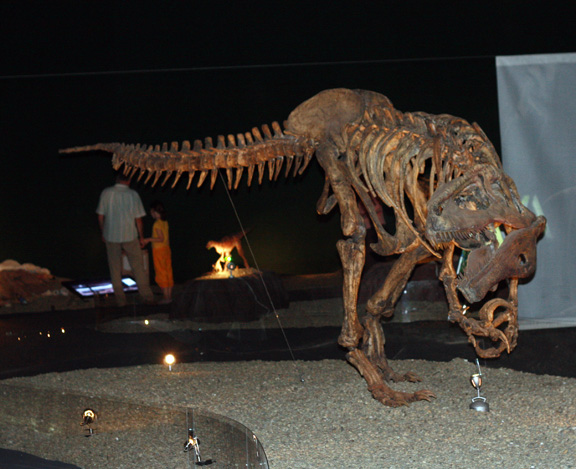Post by dinosauria101 on Mar 19, 2019 20:38:32 GMT 5
Megaraptor namunhuaiquii

Fossil range: Late Cretaceous, 88 Ma
Scientific classification
Kingdom: Animalia
Phylum: Chordata
Class: Reptilia
Superorder: Dinosauria
Order: Saurischia
Suborder: Theropoda
Superfamily: Tyrannosauroidea
Family: Megaraptora
Genus: Megaraptor
Species: Megaraptor namunhuaiquii
Megaraptor ("giant thief") is a genus of large theropod dinosaur that lived in the Coniacian stage of the Late Cretaceous. Its fossils have been discovered in the Patagonian region of Argentina. Initially thought to have been a giant dromaeosaur-like coelurosaur, it is now classified as a tyrannosauroid.
Classification
Megaraptor was initially described as a giant dromaeosaur, known primarily from a single claw (about 1 ft/0.30 m long) that resembled the sickle-shaped foot claw of dromaeosaurids. The discovery of a complete front limb, however, showed that this giant claw actually came from the first finger of the hand. The hands were unusually elongated, bearing sickle-shaped claws even more recurved than those of spinosaurids. The hand is quite distinct from other basal tetanurans, so it was not initially clear whether Megaraptor was an allosaurid, a carcharodontosaurid, a spinosauroid, or something else entirely. Subsequent studies, as well as the identification of close relatives with similar large claws on the forelimbs (see below), have helped identify Megaraptor as a primitive tyrannosauroid.

When first discovered and prior to publication, the spinosaurid Baryonyx was also reported to be a dromaeosaurid, and the allosauroid Chilantaisaurus was reported to be a possible spinosaurid, both based on the large hand claws.

A close relative of Megaraptor, Australovenator, was discovered in Australia during 2009, helping to solve the mystery of its identity. An additional dinosaur believed to be related to Megaraptor was found in southeastern Australia, Dinosaur Cove. The creature is believed to be around half the size of Megaraptor. It has not yet been named. These finds may show that the breakup of Gondwana was later than once thought.


Fossil range: Late Cretaceous, 88 Ma
Scientific classification
Kingdom: Animalia
Phylum: Chordata
Class: Reptilia
Superorder: Dinosauria
Order: Saurischia
Suborder: Theropoda
Superfamily: Tyrannosauroidea
Family: Megaraptora
Genus: Megaraptor
Species: Megaraptor namunhuaiquii
Megaraptor ("giant thief") is a genus of large theropod dinosaur that lived in the Coniacian stage of the Late Cretaceous. Its fossils have been discovered in the Patagonian region of Argentina. Initially thought to have been a giant dromaeosaur-like coelurosaur, it is now classified as a tyrannosauroid.
Classification
Megaraptor was initially described as a giant dromaeosaur, known primarily from a single claw (about 1 ft/0.30 m long) that resembled the sickle-shaped foot claw of dromaeosaurids. The discovery of a complete front limb, however, showed that this giant claw actually came from the first finger of the hand. The hands were unusually elongated, bearing sickle-shaped claws even more recurved than those of spinosaurids. The hand is quite distinct from other basal tetanurans, so it was not initially clear whether Megaraptor was an allosaurid, a carcharodontosaurid, a spinosauroid, or something else entirely. Subsequent studies, as well as the identification of close relatives with similar large claws on the forelimbs (see below), have helped identify Megaraptor as a primitive tyrannosauroid.

When first discovered and prior to publication, the spinosaurid Baryonyx was also reported to be a dromaeosaurid, and the allosauroid Chilantaisaurus was reported to be a possible spinosaurid, both based on the large hand claws.

A close relative of Megaraptor, Australovenator, was discovered in Australia during 2009, helping to solve the mystery of its identity. An additional dinosaur believed to be related to Megaraptor was found in southeastern Australia, Dinosaur Cove. The creature is believed to be around half the size of Megaraptor. It has not yet been named. These finds may show that the breakup of Gondwana was later than once thought.




